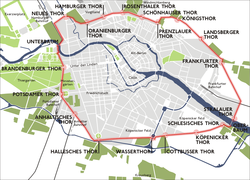Hamburg Gate
The Hamburger Tor was one of the four gates that led out of the Spandau suburb on the Berlin side of the Berlin customs wall built under Friedrich Wilhelm I from 1732 .
history
The erection of the excise wall meant the largest urban expansion of old Berlin, whereby the ramparts were removed in order to create a better connection between the inner city and the new and suburbs. On the Berlin side, the wall ring also enclosed the densely populated Spandau suburb to the north of the old town.
The infrastructure of the Spandau suburb was determined by the arterial roads to Spandau ( Oranienburger Tor ), Neuruppin-Hamburg (Hamburger Tor), Rosenthal ( Rosenthaler Tor ) and Pankow ( Schönhauser Tor ). From the middle of the 18th century, the Äußere Spandauer Vorstadt was built between the Hamburger Tor and the Oranienburger Tor. The core of this area was the "Neu-Vogtland" colony with the first Berlin tenements .
The excise wall, which initially consisted of palisades , was replaced on the Berlin side from 1787 by a massive stone wall that was partially straightened to better round off the area. In the 1860s, the demolition of the city wall began, which continued into the 1880s and did not stop at the gates, which were attractive in terms of urban planning. Of the ten gates in this section, only the New Gate of Friedrich-Wilhelm-Stadt remained.
literature
- Friedrich FA Kuntze: The old Berlin . Verlag für Kunstwissenschaft, Berlin and Leipzig 1937, p. 20.
- Heinz Ohff and Rainer Höynck (editors): The Berlin book . Stapp Verlag, Berlin 1987, ISBN 3-8777-6231-X , p. 80.
- Bodo Harenberg (editor): The Chronicle of Berlin . Chronik Verlag, Dortmund 1991, ISBN 3-88379-082-6 , p. 115.
- Herbert Schwenk: Lexicon of Berlin Urban Development ; Haude & Spenersche Verlagbuchhandlung, Berlin 2002, ISBN 3-7759-0472-7 , p. 106.

